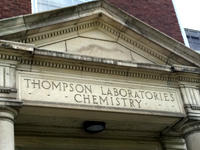
Chemistry Colloquium Dr. Robert Hansen, Indiana University
Fri, March 8th, 2019
3:30 pm - 4:30 pm
- This event has passed.

“Nitrogen Oxides at the Soil-Air Interface:
Mechanisms and Processes Affecting Atmospheric Composition”
Heterogeneous chemistry of atmospheric reactive nitrogen species (NOy, which includes HONO and N2O5) at soil surfaces represents a pathway by which reactive nitrogen can be incorporated into soil organic matter. One reaction of potential importance for biospheric nitrogen cycling is that of soil organic matter with N2O5. The mechanism of this reaction, however, is not well understood. In this study, surface and bulk measurement techniques were employed to elucidate the mechanism and products for the reaction of N2O5 with soil organic matter. This reaction was investigated using NO2+, a key intermediate in N2O5 chemistry, as a surrogate for N2O5. NO2+ was generated from concentrated nitric acid and reacted with a series of standard humic and fulvic acid samples in aqueous solution. The products of these individual reactions were analyzed with X-ray photoelectron spectroscopy and Fourier transform ion cyclotron resonance high-resolution mass spectrometry. I will present results from these analyses.
I will also discuss my work on developing instrumentation for the measurement of fluxes of trace gases from soil in remote forested areas. Soils and vegetation are important sources and sinks of reactive trace gases such as nitric oxide (NO). As these gases can have direct and indirect impacts on air quality, it is important to quantify emissions and uptake of reactive trace gases through flux measurements. To accurately capture spatial and seasonal trends, it is necessary to make measurements in a wide variety of environments over long periods of time. While multisite, long-term flux measurement networks exist for CO2, no such networks exist for reactive trace gases. As a result, there are significant uncertainties in global flux estimates for reactive trace gases such as NO. These uncertainties have implications for air quality management. One factor limiting the development of reactive trace gas flux measurement networks is the infrastructure needs for instruments that measure concentrations of these gases. Low-cost sensors, incorporating electrochemistry and infrared absorption, represent one possible solution. Their low cost ($100-200 per unit), small size (< 50 cm2 footprint) and low power consumption (< 5 W per sensor) make them ideal candidates for deployment in large multisite networks. Indeed, these sensors have been successfully deployed in networks that measure air pollutants (such as NO2, ozone, and CO). However, low-cost sensors present challenges, especially with regard to calibration, stability, and accuracy. Through careful calibration, it is possible to overcome many of these challenges. I will present a prototype unit, which incorporates low-cost sensors, for measuring NO and CO2 fluxes. I will also detail plans for the improvement of this unit and for long-term deployment of this and subsequent units in reactive trace gas flux measurement networks.
Event/Announcement Navigation
- « Computer Science Colloquium – Class of 60’s, Q + A with James Mickens
- Talk, Kevin Jerome Everson »